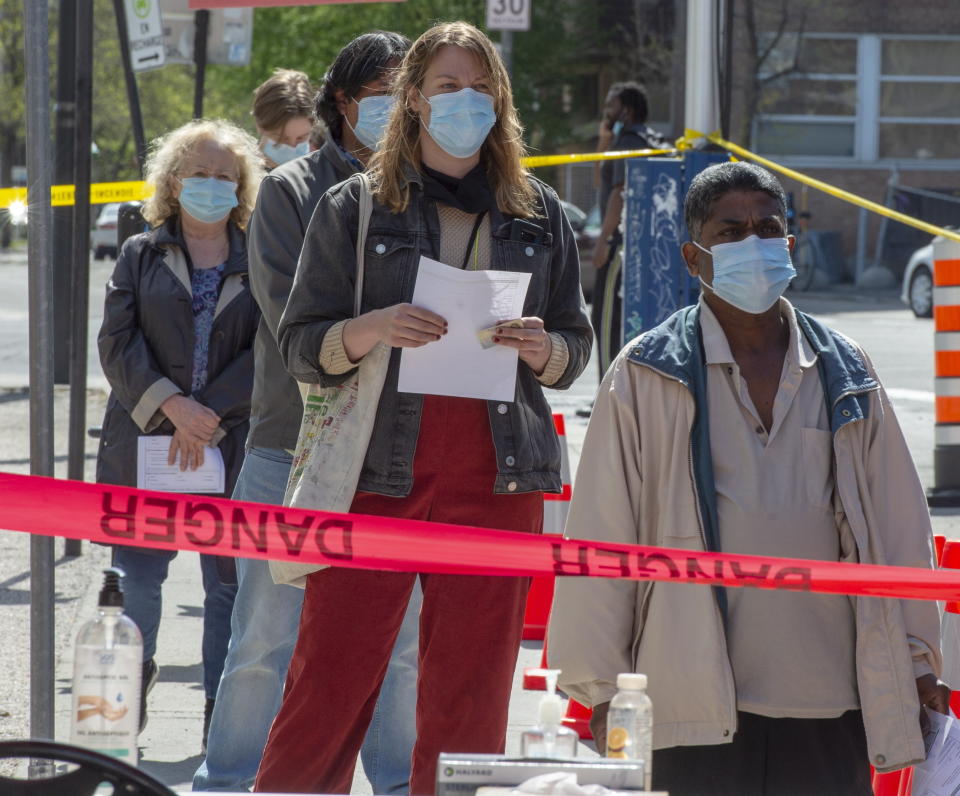Ontario's COVID-19 testing guidelines get expanded

Ontario Premier Doug Ford is asking anyone in the province who has recently spent time at a large gathering, like the one in Toronto’s Trinity Bellwoods Park on Saturday, to get tested for COVID-19.
“Why don’t you do us all a favour and go get tested now,” he said Monday. “Go to a local hospital or assessment centre and get tested.”
The downtown park received lots of media attention this weekend after attracting thousands of people, despite the province still being under an emergency order. Many of the revellers didn’t appear to be practicing physical distancing.
The province has recently seen an increase in positive cases, with an additional 404 cases reported on Monday. At the same time, Ontario is not meeting its daily testing target. The last reported numbers show that 8,170 tests were completed, which is far less than the 20,000 a day the province has committed to providing. The most recent number of tests yet to be processed is 3,883.
Who should get tested for COVID-19?
The Public Health Ontario website states that it is “not currently recommending routine testing of asymptomatic persons for COVID-19 outside of those recommended in Ministry guidance.”
This is contrary to what Premier Ford said at his recent COVID-19 media briefing.
“I gotta make sure we’re fully ramped up but I want as many people tested as possible,” he said.
“Asymptomatic, symptomatic. Wouldn't it be great if we can catch a lot of people that don’t show symptoms but are asymptomatic and spreading it?”
Those who think they might be symptomatic must have at least one symptoms of COVID-19.
According to the Provincial Testing Guideline, last updated May 14, COVID-19 symptoms include:
Fever (temperature of 37.8°C or greater)
New or worsening cough
Shortness of breath (dyspnea)
Sore throat
Difficulty swallowing
New olfactory or taste disorder(s)
Nausea/vomiting, diarrhea, abdominal pain
Runny nose, or nasal congestion – in absence of underlying reason for these symptoms such as seasonal allergies, post nasal drip, etc.
Asymptomatic, risk-based testing is available for those who believe they’ve been exposed to COVID-19, through contact to people with confirmed or suspected cases. It’s also available to those who are at risk of exposure due to their workplace, including essential workers like grocery store clerks and health care workers.
Atypical symptoms/clinical pictures of COVID-19, particularly in children, older persons, and people living with a developmental disability, can include:
Unexplained fatigue/malaise/myalgias
Delirium (acutely altered mental status and inattention)
Unexplained or increased number of falls
Acute functional decline
Exacerbation of chronic conditions
Chills
Headaches
Croup
Conjunctivitis
Multisystem inflammatory vasculitis in children
Other signs of COVID-19 can include:
Clinical or radiological evidence of pneumonia
Unexplained tachycardia, including age specific tachycardia for children
Decrease in blood pressure
Unexplained hypoxia (even if mild i.e. O2 sat <90%)
Lethargy, difficulty feeding in infants (if no other diagnosis)
What it’s like to get tested for COVID-19
Toronto resident Andrea Palmer knew that the testing process itself may be a deterrent for some people who don’t know what to expect, so when she got tested today, she shared the experience in detail on Twitter:
I just got tested for COVID-19 in Toronto. Here is what I learned:
tl;dr - fill out the online pre-screening form before you show up. (1/)— Andrea Palmer (@aehpalmer) May 25, 2020
If you are showing any symptoms OR you work outside your house OR you have come into contact with someone who has symptoms- get tested! Here are the Toronto Assessment Centres (2/) https://t.co/Cv750cWLr0
— Andrea Palmer (@aehpalmer) May 25, 2020
Some context. Ontario is under-testing. Their capacity is 20,000 tests/day. Their goal is 16,000 tests/day. And they’re way under both of those numbers. https://t.co/YYCdyuLdYc
— Andrea Palmer (@aehpalmer) May 25, 2020
The premier has called for more people to get tested. If you are in a high-risk job or you are showing ANY symptoms, you can get tested. I do not have serious symptoms. With the call for more people to get tested, I now qualify. https://t.co/QEiPiHam77
— Andrea Palmer (@aehpalmer) May 25, 2020
Restrictions on group gatherings remain
Ontario Health Minister Christine Elliott said that the number for group sizes permitted to gather wouldn’t be increased just yet, on the recommendation of Chief Medical Officer of Health Dr. David Williams.
“Given what’s happened with the number of people coming down with COVID in the last few days along with what happened this weekend...Dr. Williams is reluctant to move forward with that right away,” she said, adding that they would have to see a decrease in case numbers in order for things to change.
Since March 28, people in the province are only allowed to gather in groups of up to five, unless they live together.




